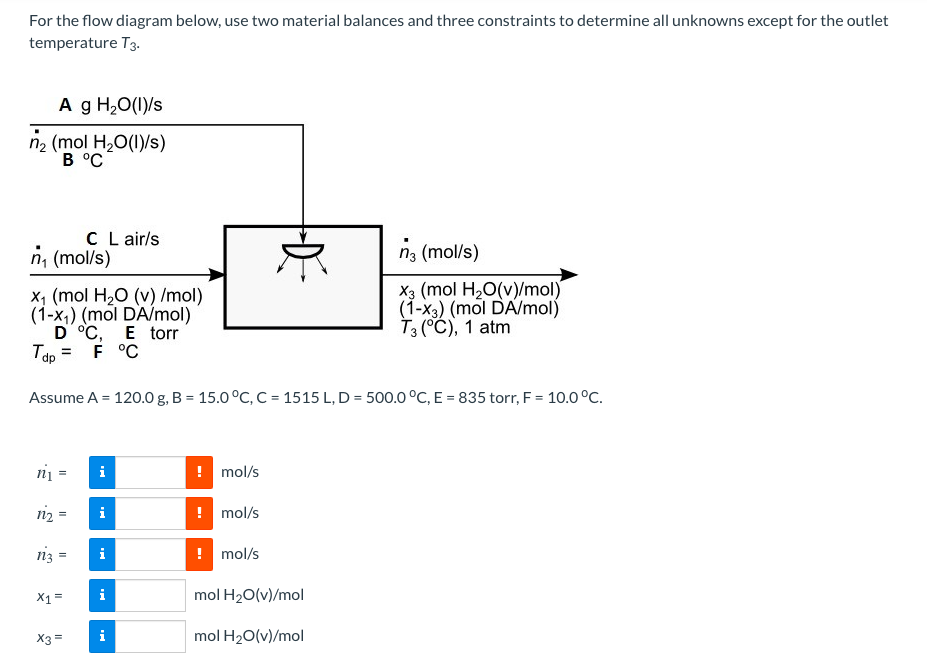For the flow diagram below, use two material balances and three constraints to determine all unknowns except for the outlet temperature T3. A g H20(1)/s n2 (mol H2O(1)/s) B °C C L air/s n, (mol/s) Пз (molls) х, (mol H,0 (v) /mol) (1-x,) (mol DA/mol) D °C, E torr Tdo = F °C X3 (mol H,O(v)/mol) (1-x3) (mol DA/mol) T3 (°C), 1 atm
For the flow diagram below, use two material balances and three constraints to determine all unknowns except for the outlet temperature T3. A g H20(1)/s n2 (mol H2O(1)/s) B °C C L air/s n, (mol/s) Пз (molls) х, (mol H,0 (v) /mol) (1-x,) (mol DA/mol) D °C, E torr Tdo = F °C X3 (mol H,O(v)/mol) (1-x3) (mol DA/mol) T3 (°C), 1 atm
Introduction to Chemical Engineering Thermodynamics
8th Edition
ISBN:9781259696527
Author:J.M. Smith Termodinamica en ingenieria quimica, Hendrick C Van Ness, Michael Abbott, Mark Swihart
Publisher:J.M. Smith Termodinamica en ingenieria quimica, Hendrick C Van Ness, Michael Abbott, Mark Swihart
Chapter1: Introduction
Section: Chapter Questions
Problem 1.1P
Related questions
Question
100%
A stream of air at 500.0 °C and 835 torr with a dew point of 10.0 °C flowing at a rate of 1515 L/s is to be cooled in a spray cooler.
A fine mist of liquid water at 15.0 °C is sprayed into the hot air at a rate of 120.0 g/s and evaporates completely.
The cooled air emerges at 1 atm.

Transcribed Image Text:For the flow diagram below, use two material balances and three constraints to determine all unknowns except for the outlet
temperature T3.
A g H20(1)/s
n2 (mol H,O(1)/s)
B °C
C L air/s
n, (mol/s)
n3 (mol/s)
X, (mol H,О (v) Imol)
(1-x,) (mol DA/mol)
D °C, E torr
Tdo =
X3 (mol H20(v)/mol)
(1-x3) (mol DA/mol)
T3 (C), 1 atm
F °C
Assume A = 120.0 g, B = 15.0 °C, C = 1515 L, D = 500.0°C, E = 835 torr, F = 10.0°C.
n =
i
! mol/s
i
! mol/s
n3
i
! mol/s
X1=
i
mol H20(v)/mol
X3 =
mol H20(v)/mol
Expert Solution
This question has been solved!
Explore an expertly crafted, step-by-step solution for a thorough understanding of key concepts.
This is a popular solution!
Trending now
This is a popular solution!
Step by step
Solved in 5 steps with 6 images

Knowledge Booster
Learn more about
Need a deep-dive on the concept behind this application? Look no further. Learn more about this topic, chemical-engineering and related others by exploring similar questions and additional content below.Recommended textbooks for you

Introduction to Chemical Engineering Thermodynami…
Chemical Engineering
ISBN:
9781259696527
Author:
J.M. Smith Termodinamica en ingenieria quimica, Hendrick C Van Ness, Michael Abbott, Mark Swihart
Publisher:
McGraw-Hill Education

Elementary Principles of Chemical Processes, Bind…
Chemical Engineering
ISBN:
9781118431221
Author:
Richard M. Felder, Ronald W. Rousseau, Lisa G. Bullard
Publisher:
WILEY

Elements of Chemical Reaction Engineering (5th Ed…
Chemical Engineering
ISBN:
9780133887518
Author:
H. Scott Fogler
Publisher:
Prentice Hall

Introduction to Chemical Engineering Thermodynami…
Chemical Engineering
ISBN:
9781259696527
Author:
J.M. Smith Termodinamica en ingenieria quimica, Hendrick C Van Ness, Michael Abbott, Mark Swihart
Publisher:
McGraw-Hill Education

Elementary Principles of Chemical Processes, Bind…
Chemical Engineering
ISBN:
9781118431221
Author:
Richard M. Felder, Ronald W. Rousseau, Lisa G. Bullard
Publisher:
WILEY

Elements of Chemical Reaction Engineering (5th Ed…
Chemical Engineering
ISBN:
9780133887518
Author:
H. Scott Fogler
Publisher:
Prentice Hall


Industrial Plastics: Theory and Applications
Chemical Engineering
ISBN:
9781285061238
Author:
Lokensgard, Erik
Publisher:
Delmar Cengage Learning

Unit Operations of Chemical Engineering
Chemical Engineering
ISBN:
9780072848236
Author:
Warren McCabe, Julian C. Smith, Peter Harriott
Publisher:
McGraw-Hill Companies, The